Structural and Functional Studies on the Interaction of GspC and GspD in the Type II Secretion System
Type II secretion systems (T2SSs) are critical for secretion of many proteins from Gram-negative bacteria. In the T2SS, the outer membrane secretin GspD forms a multimeric pore for translocation of secreted proteins. GspD and the inner membrane protein GspC interact with each other via periplasmic domains. Three different crystal structures of the homology region domain of GspC (GspCHR) in complex with either two or three domains of the N-terminal region of GspD from enterotoxigenic Escherichia coli show that GspCHR adopts an all-β topology. N-terminal β-strands of GspC and the N0 domain of GspD are major components of the interface between these inner and outer membrane proteins from the T2SS. The biological relevance of the observed GspC–GspD interface is shown by analysis of variant proteins in two-hybrid studies and by the effect of mutations in homologous genes on extracellular secretion and subcellular distribution of GspC in Vibrio cholerae. Substitutions of interface residues of GspD have a dramatic effect on the focal distribution of GspC in V. cholerae. These studies indicate that the GspCHR–GspDN0 interactions observed in the crystal structure are essential for T2SS function. Possible implications of our structures for the stoichiometry of the T2SS and exoprotein secretion are discussed.
Published in the journal:
. PLoS Pathog 7(9): e32767. doi:10.1371/journal.ppat.1002228
Category:
Research Article
doi:
https://doi.org/10.1371/journal.ppat.1002228
Summary
Type II secretion systems (T2SSs) are critical for secretion of many proteins from Gram-negative bacteria. In the T2SS, the outer membrane secretin GspD forms a multimeric pore for translocation of secreted proteins. GspD and the inner membrane protein GspC interact with each other via periplasmic domains. Three different crystal structures of the homology region domain of GspC (GspCHR) in complex with either two or three domains of the N-terminal region of GspD from enterotoxigenic Escherichia coli show that GspCHR adopts an all-β topology. N-terminal β-strands of GspC and the N0 domain of GspD are major components of the interface between these inner and outer membrane proteins from the T2SS. The biological relevance of the observed GspC–GspD interface is shown by analysis of variant proteins in two-hybrid studies and by the effect of mutations in homologous genes on extracellular secretion and subcellular distribution of GspC in Vibrio cholerae. Substitutions of interface residues of GspD have a dramatic effect on the focal distribution of GspC in V. cholerae. These studies indicate that the GspCHR–GspDN0 interactions observed in the crystal structure are essential for T2SS function. Possible implications of our structures for the stoichiometry of the T2SS and exoprotein secretion are discussed.
Introduction
Many Gram-negative bacteria use a multi-protein type II secretion system (T2SS) to secrete a wide variety of exoproteins from the periplasm into the extra-cellular milieu [1], [2], [3], [4]. In Vibrio cholerae and enterotoxigenic Escherichia coli (ETEC), cholera toxin and the closely related heat-labile enterotoxin, in addition to other virulence factors, are secreted in their folded state across the outer membrane by the T2SS [5], [6], [7]. The T2SSs are composed of 12 to 15 different proteins that form three distinct subassemblies: (i) the inner membrane platform consisting of multiple copies each of GspC, GspF, GspL and GspM with an associated cytoplasmic secretion ATPase; (ii) the pseudopilus, a filamentous arrangement of multiple copies of five different pseudopilins; and (iii) a large, pore-forming outer membrane complex, mainly consisting of the secretin GspD [8], [9].
Secretins are multimeric outer membrane proteins composed of 50–70 kDa subunits and are among the largest outer membrane proteins known. The secretin superfamily has representatives in several other multi-protein complexes engaged in transport of large macromolecular substrates across the outer membrane [10] including the T2SS, the filamentous phage extrusion machinery [11], the type IV pilus system (T4PS) [12], [13], [14], and the type III secretion system (T3SS) [15], [16]. Of these systems, the T2SS is most closely related to the T4PS which assembles and disassembles long filamentous fibers on bacterial surfaces and is responsible for diverse functions including attachment to host cells, biofilm formation, DNA uptake and twitching motility [17], [18].
The T2SS secretin GspD forms a dodecameric assembly according to electron microscopy studies [19], [20]. The C-terminal 300 to 400 residues of GspD contain the most conserved segments of the secretin superfamily, which form the actual outer membrane pore [21], [22], [23]. The N-terminal part of GspD consists of four domains: N0-N1-N2-N3 (Figure 1A) [19], [24]. The crystal structure of the N0-N1-N2 domains of the ETEC secretin GspD has been solved previously with the assistance of a single-domain llama antibody fragment or nanobody [24]. Nanobodies are the antigen-binding fragments (VHH) of heavy-chain-only camelid antibodies, which have been proven as effective crystallization chaperones for challenging targets, e.g. the T2SS pseudopilins complex [25], a trypanosomal editosome protein [26], and activated G-protein coupled receptor [27]. In the case of the secretin GspDN0-N1-N2 structure, nanobody Nb7 provided new crystal contacts and stabilized the N0-N1 domains lobe with respect to the N2 domain. The N0 domain is structurally related to domains from several proteins in bacterial multi-protein membrane complexes [28], [29], [30], [31], and to a domain of protein gp27 from T4-related bacteriophages [32]. As expected from sequence homology, the repeat N1 and N2 domains have the same fold, whereas the N3 domain is predicted to have a similar structure [24]. The fold of the N1 domain is different from that of the N0 domain and is structurally related to the eukaryotic type I KH (hnRNP K homology) domain [33]. By combining crystallographic and cryo-electron microscopy studies, it has been proposed that the N0, N1, N2 and N3 domains form the large periplasmic vestibule of the GspD dodecamer [20]. According to a number of biochemical studies, the outer membrane protein GspD has also been reported to interact with exoproteins [20], [34].
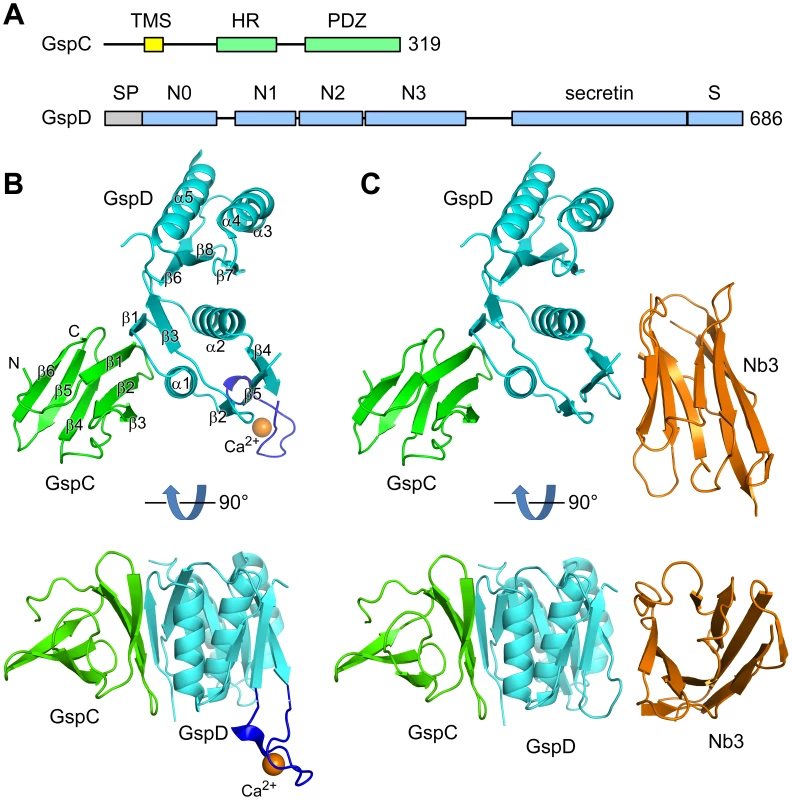
The inner membrane protein GspC consists of several domains: a short N-terminal cytoplasmic domain that is followed by the single transmembrane helix, a Pro-rich linker, the so-called homology region (HR) domain in the periplasm, a second linker and a C-terminal domain (Figure 1A) [35]. Most frequently, this C-terminal domain is a PDZ domain, but in some cases it is a coiled-coil domain [36], [37]. Crystal structures of the GspC PDZ domain showed that this domain can adopt open and closed conformations [38].
It has been shown in vivo in V. cholerae that GspC and GspD interact [39]. The interaction between GspC and GspD appears critical for the function, and possibly even for the assembly, of the T2SS [39]. Besides providing a physical link between the two membranes, either or both of these proteins or their interaction could also be important for exoprotein recognition, pseudopilus formation and release of the exoprotein through the GspD pore. Biochemically, we showed that the HR domain of GspC is the key part of GspC that interacts with the periplasmic GspDN0-N1-N2 [38]. This interaction was confirmed and further investigated recently in the plant pathogen Dickeya dadantii, a species previously called Erwinia chrysanthemi [40]. The interaction between GspC and GspD of Xanthomonas campestris has also been observed in vitro [37].
We report three structures of GspCHR in complex with N-terminal domains of GspD that provide a structural basis to understand the functional interplay between the inner membrane platform and the outer membrane secretin of the T2SS. The observed interface led to the design of experiments to probe the importance of specific amino acids by biochemical and in vivo studies. Altering interface residues disabled the interaction of GspC and GspD in a bacterial two-hybrid system. It also abrogated protease secretion and had a dramatic effect on the localization of GspC in the cell envelope in V. cholerae. Together these results show the physiological importance of the molecular interactions observed between the inner and the outer platform. In addition, the resultant structure of the HR domain of GspC means that the structures of essentially all globular domains of the major T2SS proteins are presently known. The structures of ETEC GspCHR in complex with N-terminal domains of GspD reported here are the first to reveal critical interactions between the inner membrane platform and the outer membrane complex of the T2SS at the atomic level.
Results
Structures of Three GspC–GspD Complexes from ETEC
A complex of ETEC GspCHR and GspDN0-N1-N2 could be obtained but yielded only poorly diffracting crystals. To improve the quality of these crystals, we screened the same set of GspD specific nanobodies that had been used previously to solve the structure of GspDN0-N1-N2 [24] as crystallization chaperones for the GspCHR–GspDN0-N1-N2 complex. Using nanobody Nb3, we obtained crystals of a ternary ETEC GspCHR–GspDN0-N1-N2–Nb3 complex, which diffracted initially only to ∼5.5 Å resolution. Nevertheless, a partial molecular replacement structure revealed that the HR domain of GspC interacts with the lobe formed by the N0-N1 domains of GspD. To better characterize this interaction we also crystallized smaller complexes of GspCHR–GspDN0-N1 with or without nanobodies. To assist in crystallographic phasing, we also engineered a lanthanide-binding tag (LBT) into the N0 domain of GspDN0-N1 [41]. The LBT to GspDN0-N1 facilitated crystal growth and the resultant crystals of the binary GspCHR–GspDN0-N1 complex diffracted to better than 2.7 Å resolution, with the LBT engaged in multiple crystal contacts (Figure S1). The structure of this binary GspCHR–GspDN0-N1 complex was solved by molecular replacement and refined with good crystallographic and stereochemical statistics (Table 1). In parallel, we also obtained crystals and solved the 4 Å resolution structure of a ternary GspCHR–GspDN0-N1–Nb3 complex, and also improved the diffraction of crystals of the GspCHR–GspDN0-N1-N2–Nb3 complex to ∼4 Å resolution (Table 1, Figure S2).
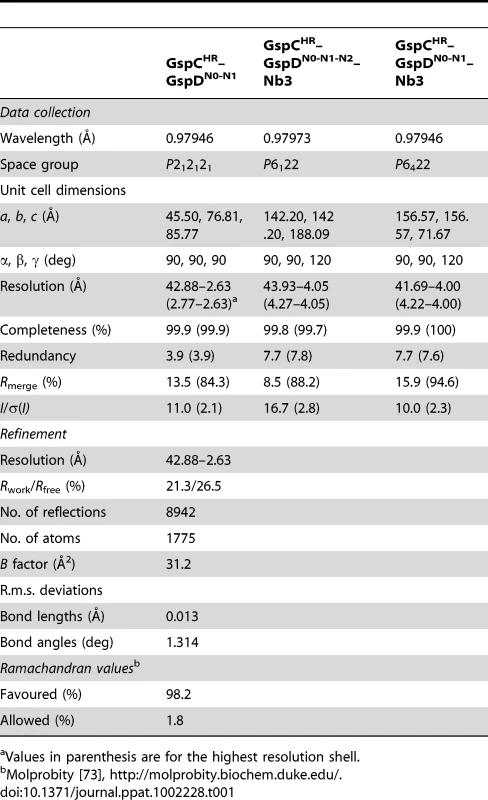
The three multiprotein structures obtained from different crystal forms allow a detailed description of the interactions between GspC and GpsD. In all three structures, the N0 domain of GspD interacts exclusively with the HR domain of GspC. In the 2.63 Å resolution binary complex, the LBT introduced into GspDN0 faces away from the interface with GspC (Figure 1B). In the two low-resolution ternary complex structures, the nanobody Nb3 binds the N0 domain of GspD, opposite to the binding site of the HR domain of GspC (Figure 1C and Figure S3). In all three structures the HR domain binds in very similar orientation to GspD, relative to its N0 domain. Hence, neither the LBT nor the nanobody appears to affect the binding mode of GspC to GspD. Because the structure of the binary GspCHR–GspDN0-N1 complex has the highest resolution, this structure will be used below to analyze the specific features of the GspC–GspD interaction.
Structure of the HR Domain of GspC
The HR domain folds into a β-sandwich formed by six consecutive β-strands arranged as two three-stranded anti-parallel β-sheets (Figure 1B). The residues between strands β3 and β4 adopt an approximately one-turn helical conformation. In its folded structure as seen in the complex with GspDN0-N1 (Figure 2), the distribution of charges on the surface of GspCHR is quite uneven with the main hydrophobic surface interacting with GspDN0. Part of the remaining HR surface that is not involved in the GspD interaction (upper panel Figure 2) has a preponderance of negative charges and a deep pocket defined by residues Val127, Ile142 and Leu157. The other side of the HR domain (lower panel Figure 2) displays a mix of positive, negative and hydrophobic patches. The functions of these features during assembly and action of the T2SS, if any, remain to be determined.
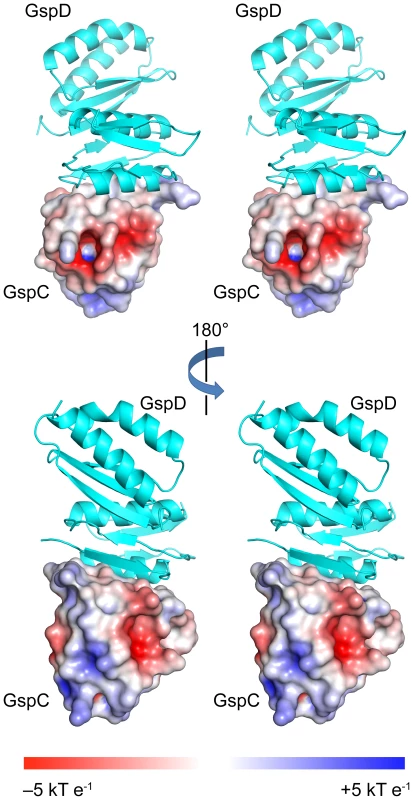
The Comparison of the HR Domain of GspC from the T2SS and PilP from the T4PS
The closest known structural homolog of the HR domain of ETEC GspC appears to be Neisseria meningitidis lipoprotein PilP (NmPilP) which interacts with the secretin of the T4PS [42]. The HR domain of GspC and the core domain of NmPilP superimpose with an r.m.s. deviation of 1.6 Å and 25% sequence identity over 59 residues (Figure 3). The structure of NmPilP has been described as a β-sandwich composed of 7 β-strands [42]. Whereas residues 154–156 of GspC, corresponding to strand β4 of NmPilP, make some main chain hydrogen bonds to residues in strand β4 of GspC (corresponding to β5 of NmPilP), the secondary structure assignment algorithm of DSSP [43] does not classify these residues as β-structure.
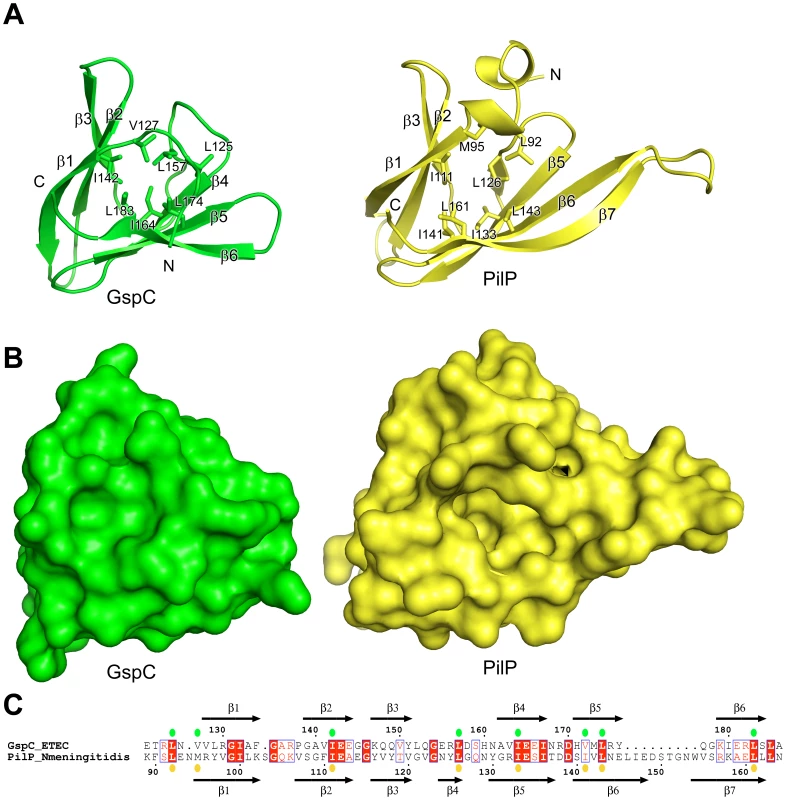
A potential binding site has been described for the core NmPilP domain [42]. It consists of a hydrophobic crevice on the open end of the β-sandwich. The residues that create this hydrophobic groove appear to be conserved between these two proteins from the T2SS and the T4PS when they are superimposed (Figure 3C). However, the area equivalent to the NmPilP pocket is covered by residues N-terminal to strand β1 in ETEC GspC and, therefore, the NmPilP pocket is absent in GspC (Figure 3B). These differences do not appear to stem from crystal contacts in the GspCHR–GspDN0-N1 structure. Moreover, these residues are well conserved (Figure S4A) and contribute to the hydrophobic core of the HR domain. The full implications of the global structural similarity between the core PilP domain of the T4PS and the HR domain of GspC from the T2SS remain to be established, but it is in line with several known similarities between the T2SS and T4PS [17], [18].
The GspC–GspD Interface
The interface between GspCHR and GspDN0 buries 1280 Å2 of accessible surface area with a calculated ΔG of interaction of −5.4 kcal×mol−1 as assessed by the PISA server (Figure 4) [44]. The overall shape of the interface is relatively flat with a small concave area on the GspD surface. A total of 18 residues from GspCHR and 19 residues from GspDN0 engage in a combination of hydrophobic interactions and hydrogen bonds. The first three β strands of GspCHR and the first β strand plus the subsequent helix α1 of GspDN0 are the major contributors to the interface. The majority of the hydrogen bonds are formed by an antiparallel arrangement of strand β1 of GspCHR and strand β1 of GspDN0 (Figure 4C). This β-strand augmentation is frequently observed in protein–protein interfaces [45]. Several nonpolar residues are engaged in intermolecular hydrophobic interactions, e.g. Ala133/Val141 from GspC, and Phe5/Phe9 from GspD. The hydrophobic nature of these interacting residues is well conserved, with GspC residue 133 being Ala, Leu, Val or Met; GspC residue 141 either a Val or Ile; GspD residue 5 a Phe or Tyr; and GspD residue 9 a Phe according to a family sequence alignment (Figure S4). Nonetheless, the GspC–GspD interface provides a species-specific connection point between outer and inner membrane assemblies of the T2SS as has been observed in genetic complementation studies [46], [47].
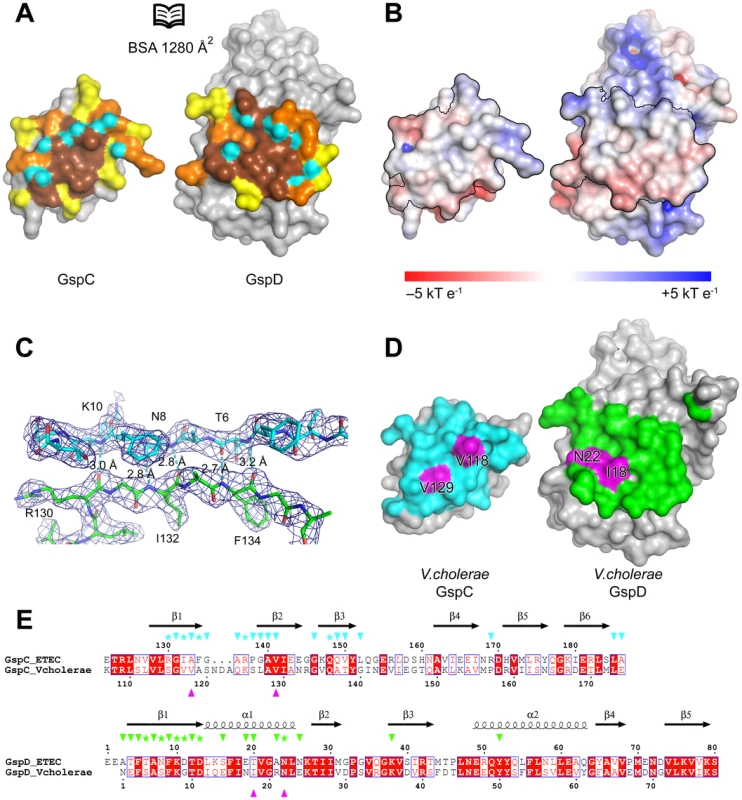
Based on the GspCHR–GspDN0-N1 structure, we selected several well-conserved interface residues for subsequent substitutional analysis. Ala133 and Val141 from ETEC GspC (equivalent to Val118 and Val129 from V. cholerae GspC, respectively; Figure 4E) and Thr20 from ETEC GspD (equivalent to Ile18 of V. cholerae GspD) are completely buried upon complex formation and are located in the center of the interacting surfaces (Figure 4D). Asn24 from ETEC GspD (equivalent to Asn22 of V. cholerae GspD) makes a hydrogen bond with the main chain oxygen of ETEC GspC Arg137. We evaluated the role of these residues on complex formation of truncated forms of GspC and GspD in a bacterial two-hybrid system and in a functional V. cholerae secretion assay in vivo. We also assessed the effect of interface substitutions on the distribution of GspC in the cell envelope of V. cholerae.
Tests of GspC–GspD Interactions in the Bacterial Two-hybrid System
The effect of several interface substitutions on the ability of GspD to associate with GspC was assayed in a bacterial two-hybrid system based on reconstitution of activity of the catalytic domain of Bordetella pertussis adenylate cyclase when T18 and T25 fragments are fused to interacting proteins (see Methods) [48]. VcGspD–T18 with a conservative Asn22Gln substitution retained the ability to interact with T25–VcGspC and formed dark red colonies on indicator agar. In contrast, VcGspD–T18 with either an Asn22Arg substitution or an Ile18Asp substitution lost the ability to interact with T25–VcGspC and formed colorless colonies (Table 2). Two variants of T25–VcGspC, with either Val118Arg or a Val129Arg substitution, also lost the ability to interact with VcGspD–T18 and formed colorless colonies in the bacterial two-hybrid system.
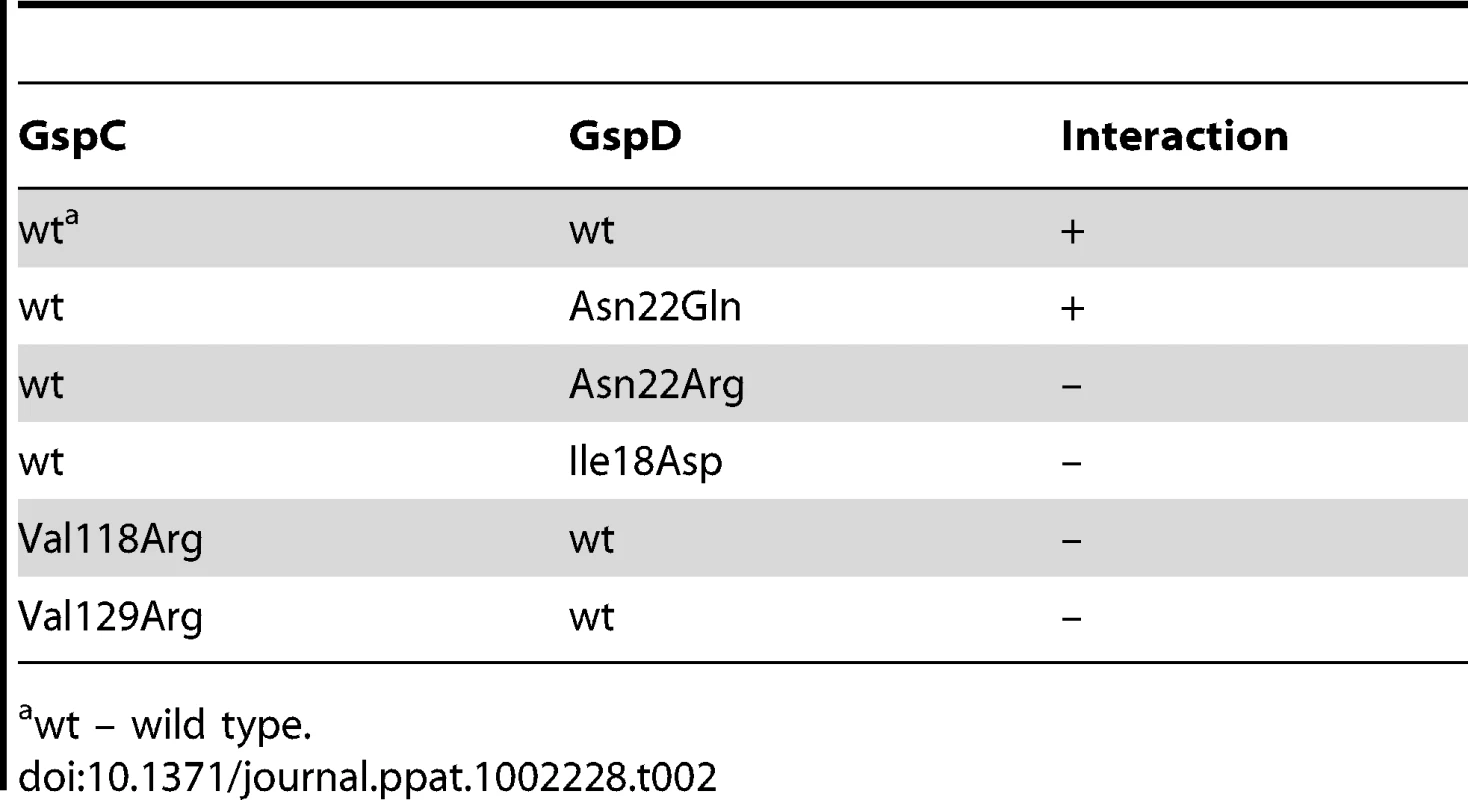
Mutations in the GspC–GspD Interface Interfere with Protease Secretion in V. cholerae
The functional importance of residues involved in the GspC–GspD interface was also assessed in vivo by monitoring the effect of the Ile18Arg and Asn22Tyr mutations in VcGspD on the extracellular secretion of protease by V. cholerae. No protease secretion was observed when plasmid-encoded VcGspDIle18Arg/Asn22Tyr was produced in a V. cholerae mutant strain lacking the gene encoding VcGspD (Figure 5A), indicating that the simultaneous exchange of these two amino acids prevents protein secretion by the T2SS. The singly substituted variants, however, remained functional (Figure 5A). Immunoblot analysis of cell extracts from the ΔgspD mutant strain producing plasmid-encoded wild type and mutant VcGspD showed that the double VcGspD mutant protein was made at levels similar to that of wild-type VcGspD (Figure 5B).
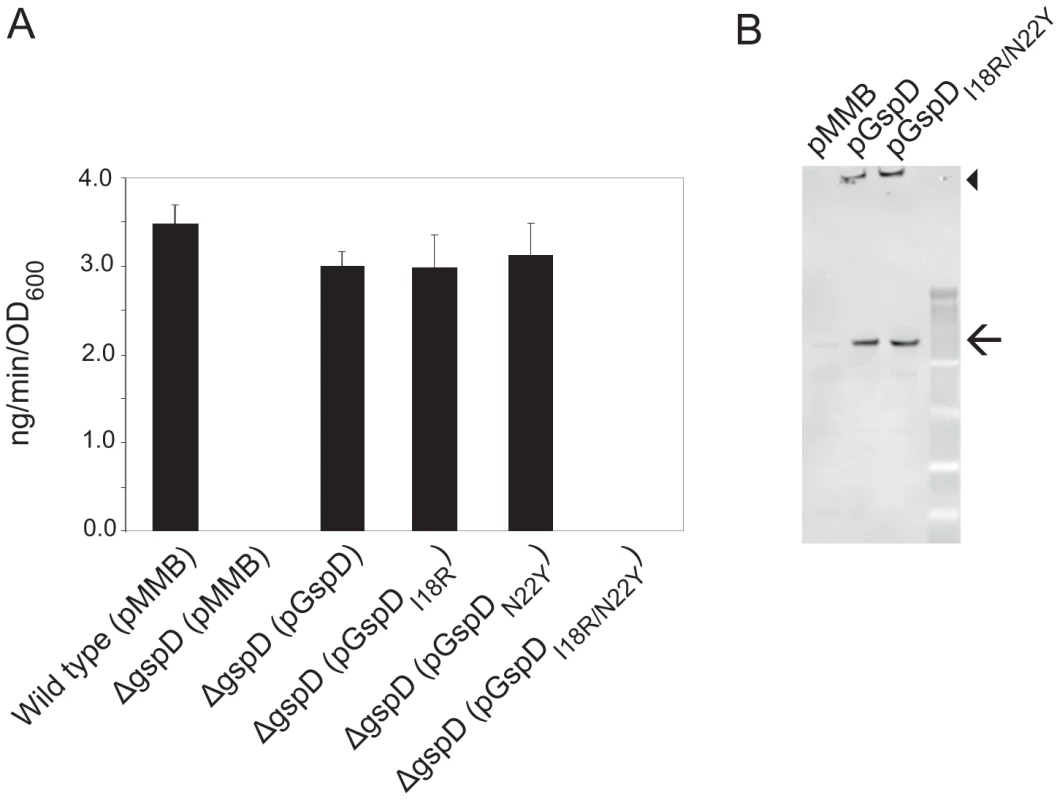
Distribution of GFP-VcGspC in V. cholerae Cells
Using V. cholerae strains producing chromosomally encoded VcGspC fused to the green fluorescent protein (GFP), we visually examined the effects of substitutions in the GspC–GspD interface on subcellular localization of GspC. GFP-VcGspC forms fluorescent foci in the V. cholerae cell envelope, which disperse upon deletion of the gene encoding VcGspD and reappear when the deletion strain is complemented with plasmid-encoded VcGspD (Figure 6, first and second panels) [39]. The substitution of wild-type VcGspD with VcGspDIle18Arg/Asn22Tyr resulted in loss of fluorescent foci and dispersal of the fluorescence in a manner indistinguishable from cells that do not have the gene encoding VcGspD at all (Figure 6, fourth panel). This result suggests that residues Ile18 and Asn22 of VcGspD are critical for the incorporation of GFP-VcGspC fusion protein into fluorescent foci, and supports the suggestion that the interaction between GspC and GspD observed in the crystal structure of GspCHR in complex with GspDN0-N1 (Figure 4) is physiologically relevant. Based on these results, it appears that VcGspD has to interact directly with VcGspC in order to support its focal distribution in V. cholerae.
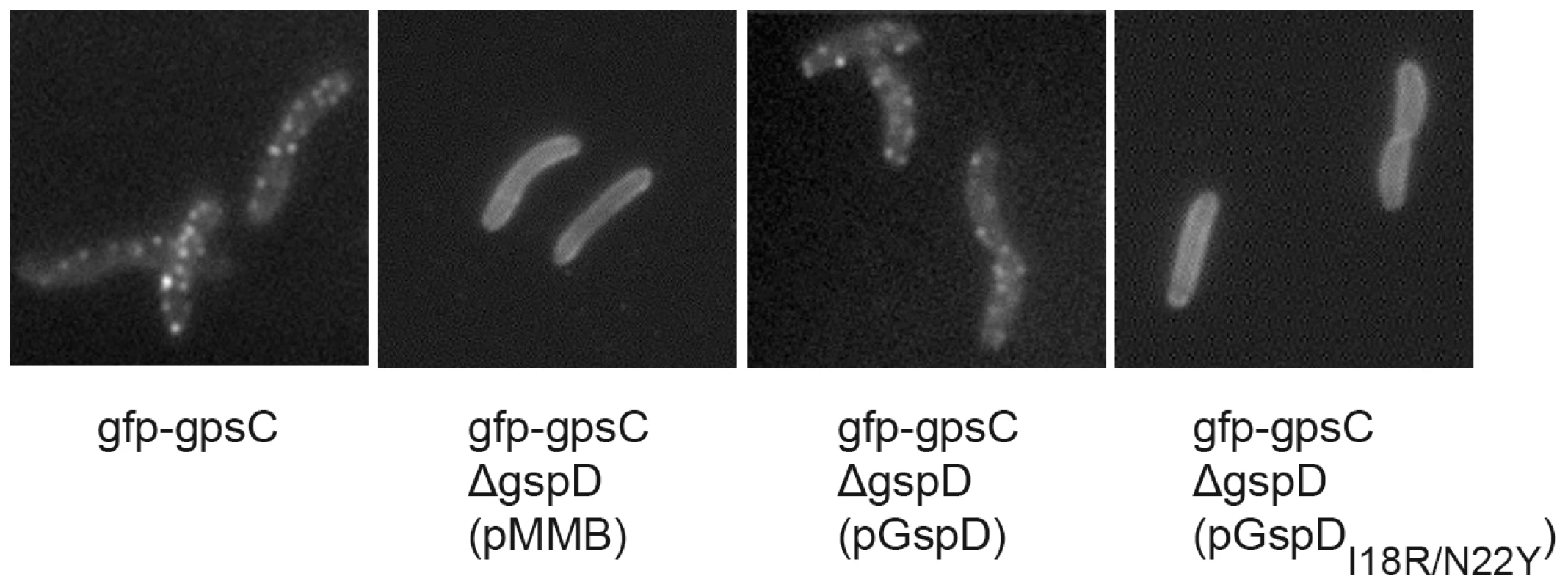
Discussion
The current paper reveals for the first time key structural features of critical interactions between the outer membrane secretin GspD and the inner membrane protein GspC of the T2SS. The crystallographic studies benefited from the set of nanobodies against the N0-N1-N2 domains of GspD from ETEC [24] and from the incorporation of a lanthanide-binding tag (LBT) into ETEC GspDN0. The three GspC–GspD crystal structures elucidated reveal the same 1280 A2 interface involving the HR domain of GspC and the N0 domain of GspD. The crucial role of this interface was tested and confirmed by subsequent biochemical and functional studies. These results have interesting implications for our understanding of the T2SS and related secretion systems in many bacteria as discussed below.
The Mutual Orientation of the N0 and N1 Domains of GspD
The structures of the first two domains of related secretins have been determined in two prior studies: ETEC GspD from the T2SS and EPEC EscC from the T3SS [24], [49]. The relative orientations of the N0 and N1 domains in these two studies appeared to be remarkably different: when the N1 domains of the T2SS and T3SS secretins are superimposed, the N0 domains are rotated by not less than 143 degrees [10]. This raises an important question as to the actual orientation of these two domains in the T2SS and T3SS secretins.
Regarding the T2SS, the relative orientations of the N0 and N1 GspD domains can now be compared in two high resolution structures, i.e. in the current structure of the binary complex of ETEC GspCHR and GspDN0-N1, and in the previously determined binary complex of ETEC GspDN0-N1-N2 in complex with Nb7 [24]. The linker between the N0 and N1 subdomains is disordered in both these high resolution structures. The interface and relative orientation of the N0 and N1 subdomains, however, is essentially the same in the two structures despite the binding of either Nb7 or the presence of the LBT insertion into the N0 domain: the superposition of the two N0 domains results in an r.m.s. deviation of 0.49 Å for 72 Cα pairs (Figure S5). Taking also into account the two new low resolution structures of the ternary complexes of GspCHR–GspDN0-N1–Nb3 and GspCHR–GspDN0-N1-N2–Nb3 (Figure S3), then the N0-N1 lobe in the T2SS secretin GspD is observed as the same compact unit in four different crystal structures, independent of the presence or absence of a GspCHR domain, Nb molecules or crystal contacts. The available data suggest that the N0-N1 orientation in GspD is a characteristic feature in the T2SS. However, we cannot exclude the possibility that the relative orientation of the N0 and N1 domains may change as the secretin oligomerizes. Only high resolution structures of the dodecameric secretin will resolve this question.
Since the N0-N1 lobe of the T2SS secretin fits well into the cryo-electron microscopy reconstruction of VcGspD [20], and the N0 and N1 domains of the T3SS secretin fit well into a cryo-electron microscopy density of the Salmonella typhimurium needle complex [16], it might be that the N0 and N1 domains of these related secretins adopt different mutual orientations in the assembled T2SS and T3SS in vivo as observed in crystals. Obviously further studies are required to confirm this hypothesis where it also should be kept in mind that secretins are dynamic proteins and multiple orientations of N-terminal secretin domains might transiently occur during the secretion process [10].
The GspC–GspD Crystal Structure and Functional Studies
The crystal structure indicates that a number of residues are critical for the interactions of ETEC GspC and GspD (Figure 4). Moreover, these residues are conserved in the family sequence alignment (Figure S4). As many mutants and other useful reagents have already been generated and developed for studies of the T2SS in V. cholerae, subsequent probing of the importance of these residues for the interaction was carried out in three different ways using V. cholerae GspC and GspD homologues. The two-hybrid studies showed that substitutions Val118Arg and Val129Arg in VcGspC, and Asn22Arg in VcGspD, abrogated the interaction between GspCHR and GspDN0-N1-N2 from V. cholerae (Table 2). The secretion of protease by V. cholerae was also greatly diminished by substitutions Ile18Arg/Asn22Tyr in full length VcGspD (Figure 5). Finally, the same Ile18Arg/Asn22Tyr variant of VcGspD altered the distribution of full-length VcGspC in the inner membrane of V. cholerae, possibly by interfering with normal assembly of the inner membrane platform of the T2SS (Figure 6). Taking all data together, we conclude that the substitutions altering the interface of GspC with GspD in V. cholerae affect the interactions of GspC with GspD as demonstrated both in a bacterial two-hybrid system and by analysis of protease secretion by the T2SS in V. cholerae.
Interactions between GspC and GspD from D. dadantii have been recently investigated [40]. This study confirmed the interactions between GspCHR and the N-terminal domains of GspD reported earlier for V. vulnificus homologs [38]. A GST-fusion of residues 139–158 of DdGspC (corresponding to residues 168–187 in ETEC GspC) co-purified with both DdGspDN0 and DdGspDN1-N2-N3 [40]. The 139–158 residues of DdGspC were therefore designated as secretin interacting peptide (SIP). In a homology model of DdGspCHR–GspDN0-N1 complex, based on our crystal structure, this fragment is located far from the interface (Figure S6). It appears that this segment forms an anti-parallel pair of β-strands, β5 and β6, in the ETEC GspCHR crystal structure, with β6 at the surface and β5 located between strands β6 and β4 (Figure S6). Furthermore, the substitutions introduced into the DdGspC 139–158 fragment had no effect on the interaction with DdGspDN0, whereas one substitution, Val143Ser, prevented DdGspC interaction with DdGspDN1-N2-N3 [40]. The same substitution, when introduced into full length DdGspC, also interfered with secretion in D. dadantii. We also mapped these substitutions onto the homology model of the DdGspC–GspD complex and it is clear that none of them are buried in the GspC–GspD interface (Figure S6). The only substitution that had an effect on secretion, Val143Ser, replaces a buried hydrophobic residue in the core of DdGspCHR with a polar residue that would likely be detrimental to the HR domain stability. This is in agreement with the finding that this substitution in GST-DdGspC128-272 resulted in a protein that is degraded in the cells [40]. A more conservative Val143Ala substitution in full length DdGspC appeared to largely support secretion of pectinases, in agreement with the less drastic change of the nature of the side chain, which could result in a larger proportion of properly folded protein than in the case of the Val143Ser variant. Therefore, the ETEC GspCHR–GspDN0-N1 structure explains several experimental results of the studies on DdGspC–GspD interactions [40]. The observations that a GST-fusion of the DdGspC 139–158 fragment is capable of interacting with fragments of the secretin in the absence of both the rest of the HR domain and the rest of the secretin, and of interfering with pectinase secretion when over-expressed in wild type D. dadantii, are difficult to interpret precisely. Additional studies are required to show that such interactions are not the result of non-specific interactions, possibly due to exposed hydrophobic residues of the peptide which are normally buried in the complete HR domain.
T2SS Stoichiometry
The implications of the GspCHR–GspDN0 interactions unraveled by our studies for the architecture of the T2SS are intriguing. The three new structures in the current paper show that one GspCHR domain interacts with one GspDN0 domain, which suggests a 1∶1 ratio of GspC and GspD in the assembled T2SS. Since the stoichiometry of full length GspC and GspD has not been established yet in the context of a functional T2SS, it is of interest to see if the current complex of GspCHR–GspDN0 is compatible with the dodecameric ring of GspDN0-N1 derived recently by a combination of crystallographic and electron microscopy studies [20], [24]. Superimposing the GspCHR–GspDN0 complex twelve times onto the N0-domains of the GspDN0-N1 ring results in a double ring structure where the GspCHR subunits added do not interfere with the formation of the GspDN0-N1 ring. Although this procedure does result in some clashes between the subunits of the GspCHR ring, specifically between residues of the β2-β3 loop of one subunit and residues just prior to β6 in a neighboring subunit, small conformational changes in these loops, or minor adjustments in the mutual orientation of domains in the GspDN0 ring, or both, might alleviate these close contacts. If this would be the case, the GspD dodecamer would interact with twelve GspC subunits in the assembled T2SS (Figure 7A). Alternatively, only alternating GspD subunits of the dodecameric secretin might interact with GspCHR, obviously removing close contacts between the then well separated GspCHR subunits. In this case, the GspD dodecamer would interact with six GspC subunits (Figure 7B).
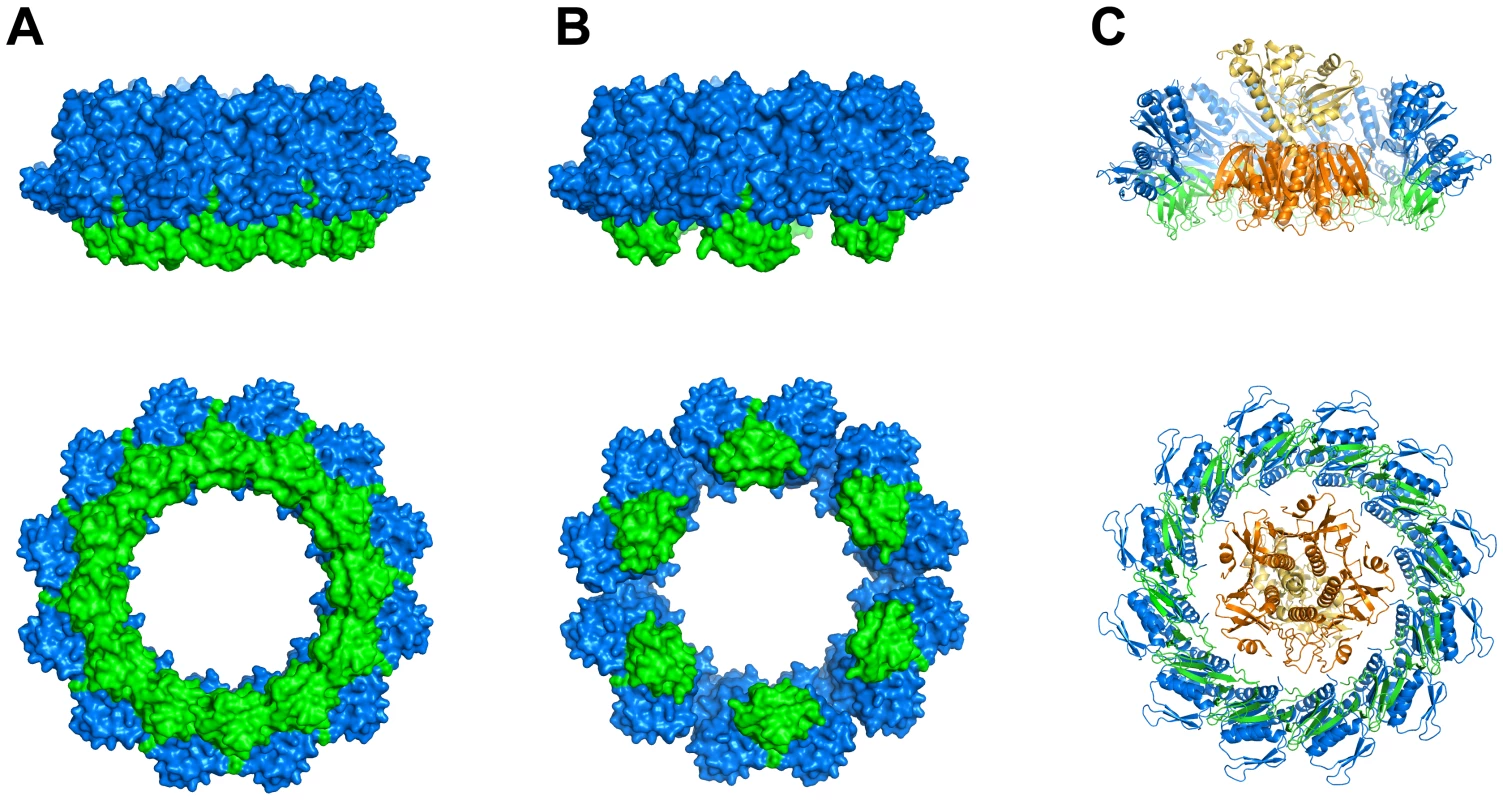
These two alternatives for the interface of the outer membrane complex and the inner membrane platform can be combined with previous studies on the T2SS even though the ratio between GspC and the other components of the inner-membrane platform complex is currently unknown. Yet, the following observations are of interest for the T2SS stoichiometry puzzle:
(i) the secretion ATPase GspE of the T2SS has been suggested to be a hexamer [50], [51];
(ii) the cytoplasmic domain of the inner membrane T2SS protein GspL forms a 1∶1 complex with GspE [52];
(iii) homologs of GspM and of the cytoplasmic domain of GspL from the T4PS have been reported to form heterodimers [53], [54];
(iv) there are a few cases of gene fusion of the T4PS proteins PilP and PilO (e.g. Pseudomonas putida PilO-PilP, Uniprot entry Q88CU9) in the T4PS. PilP is a GspCHR homolog (Figure 3) and PilO is proposed to be a homolog of the inner membrane protein GspM from the T2SS [54], [55]. The presence of PilO–PilP fusions may imply a 1∶1 stoichiometry of these proteins in the T4PS and, in view of the homology between the T4PS and the T2SS, a GspM:GspC ratio of 1∶1 in the T2SS as well.
These four observations suggest that GspE, GspL, GspM and GspC might be present in an equimolar ratio in the inner membrane platform. In view of the likely hexameric nature of GspE, this implies the presence of six subunits of each of these proteins in the assembled T2SS. If the GspD dodecamer would interact with six GspC subunits (Figure 7B), then this arrangement would agree well with six subunits each of GspC, GspL, GspM and GspE in the inner membrane platform. If a GspD dodecamer, however, would interact with twelve GspC subunits in the assembled T2SS (Figure 7A), then, a stoichiometry mismatch is likely to occur somewhere along the GspC–GspL–GspM–GspE chain of interactions in the inner membrane platform. This could be possible in spite of the evidence in points (i) to (iv) above for an equimolar ratio of these four proteins in the T2SS since e. g. points (iii) and (iv) are rather indirect and derived from observations on T4PS proteins. Clearly, the stoichiometry of the T2SS remains a fascinating topic for further studies, where the number of GspF subunits, the only T2SS protein which spans the inner membrane multiple times, also remains to be determined.
Implications for Exoprotein Secretion
Another major outstanding question is the recognition of exoproteins by the T2SS. Interestingly, the inner diameter of the dodecameric GspCHR–GspDN0-N1 double ring is ∼68 Å, which implies that a large exoprotein like the cholera toxin AB5 heterohexamer [56] just fits into this ring (Figure 7C). This is in agreement with recent electron microscopy studies which indicate that the B-pentamer of cholera toxin can bind to the entrance of the GspD periplasmic vestibule [57]. The periplasmic domains of GspD and of GspC have been implicated in this crucial exoprotein recognition function [34], [46], [57], [58], [59], but the specific details of exoprotein–T2SS interactions remain to be uncovered. The accumulation of recent structural and biochemical data provides a platform for asking increasingly precise questions regarding the many remaining mysteries still pertaining to the architecture and mechanism of the sophisticated T2SS.
Methods
Expression and Purification of GspC and GspD for Crystallization
ETEC GspDN0-N1-N2 (residues 1–237; numbering corresponds to mature protein sequence) was expressed and purified as described [24]. The DNA sequence corresponding to residues 1–165 of ETEC GspD was PCR amplified and cloned into the pCDF-NT vector to obtain a GspDN0-N1 expression construct. pCDF-NT is a modified pCDF-Duet1 vector (Novagen) encoding an N-terminal His6-tag sequence and a TEV protease cleavage site. The DNA sequence corresponding to residues 122–186 of ETEC GspC was PCR amplified and cloned into a pCDF-NT vector to obtain a GspCHR expression construct.
A lanthanide binding tag (LBT) was introduced into GspDN0-N1 construct in order to assist with crystallographic phase determination and promote crystal formation. In order to decrease the flexibility of the LBT, we introduced it into the loop between two adjacent β-strands rather than at the termini. The design was based on the crystal structure of ubiquitin with the double LBT (PDB 2OJR) [41] where two β-strands flank one of the LBT. The LBT sequence YIDTNNDGYIEGDEL was inserted between residues Met70 and Val74 of GspDN0 (Figure S4B) using the polymerase incomplete primer extension method [60]. While this manuscript was in preparation, a similar approach for the LBT insertion was successfully applied to a model protein, interleukin-1β [61].
GspDN0-N1 was expressed at 25°C in BL21(DE3) cells (Novagen) in LB medium containing 50 µg×ml–1 streptomycin. Protein production was induced with 0.5 mM IPTG. Cells were harvested 3 h after induction. GspDN0-N1 variants with or without LBT were purified by Ni-NTA agarose (Qiagen) chromatography followed by His6-tag cleavage with TEV protease; a second Ni-NTA chromatography to remove His6-tag, uncleaved protein and His-tagged TEV protease; and a final size-exclusion chromatography using Superdex 75 column (GE Healthcare). GspCHR was expressed and purified under same conditions as GspDN0-N1. The proteins were concentrated, flash-frozen [62] and stored at −80°C. Se-Met-labeled proteins were expressed using metabolic inhibition of methionine biosynthesis [63] and purified using the protocols for native proteins.
Purification of Nanobodies
The nine nanobodies generated against ETEC GspDN0-N1-N2 were expressed and purified as described previously [24].
Crystallization, Data Collection and Structure Determination
ETEC GspCHR, GspDN0-N1-N2 and individual nanobodies were mixed at 1∶1∶1 molar ratio, concentrated to 4–8 mg×ml−1 total protein concentration and subjected to crystallization conditions screening by the vapor diffusion method at 4 or 21°C. The crystallization conditions were identified using SaltRx (Hampton Research) and JCSG+ (Qiagen) screens. The complex of GspCHR–GspDN0-N1-N2–Nb3 was crystallized in 1.2 M lithium sulfate, 0.1 M Tris-HCl pH 7 at 4°C. The crystals were gradually transferred to precipitant solution supplemented with 30% glycerol and flash-frozen in liquid nitrogen. Initial crystals diffracted to 5.5 Å resolution and optimized crystals with Se-Met substituted GspDN0-N1-N2 showed improved diffraction to 4.6 Å. Data were processed and scaled using XDS [64]. The structure was solved by molecular replacement using Phaser [65]; the search models included the GspDN0-N1 structure (PDB 3EZJ) [24], a camelid antibody fragment (PDB 1QD0) [66], and a homology model of GspCHR obtained using the I-TASSER server [67] and the N. meningitidis PilP structure as template (PDB 2IVW) [42]. The N2 domain of GspD could not be located in the electron density maps due to statistical disorder (Figure S2).
The complex of GspCHR–GspDN0-N1 with an engineered LBT in the GspDN0 domain was crystallized in 0.9 M magnesium sulfate, 0.1 M bis-tris propane pH 7.0 at 21°C. The crystals were transferred to precipitant solution supplemented with 20% ethylene glycol and flash-frozen in liquid nitrogen. The structure of the GspCHR–GspDN0-N1 complex was solved by molecular replacement using Phaser and rebuilt using Buccaneer [68] and Coot [69]. The metal binding site of the LBT appears to be occupied by a Ca2+ ion based on the electron density and the B factor values after refinement (Figure S1). Most likely, Ca2+ ions were acquired during E. coli expression, which prevented Tb3+ ions binding during treatment of purified protein according to a published protocol [41]. The capture of ions during heterologous expression by Ca2+ binding proteins has been observed previously for the major pseudopilin GspG [70]. The structure was refined with REFMAC [71] using translation, libration and screw-rotation displacement (TLS) groups defined by the TLSMD server [72]. The quality of the structure was assessed using the Molprobity server [73].
The ternary GspCHR–GspDN0-N1–Nb3 complex was crystallized in 0.7 M sodium citrate, 0.1 M bis-tris propane, pH 7.0 at 21°C. The crystals were cryoprotected using 20% ethylene glycol. The structure of the GspCHR–GspDN0-N1–Nb3 complex was solved by molecular replacement using Phaser with refined GspCHR and GspDN0-N1 fragments from our GspCHR–GspDN0-N1 structure as search models (Figure S3).
Protein–protein interfaces were evaluated using the PISA server [44]; structural homologs were searched for using the DALI server [74]; the electrostatic surface potential was calculated using APBS [75]; figures were prepared using PyMol [76].
Two Hybrid Analysis of VcGspC and VcGspD Domain Interactions
Interaction between protein domains was detected by the ability of fusion proteins containing the enzymatically inactive T18 and T25 fragments of adenylate cyclase toxin from Bordetella pertussis to confer adenylate cyclase activity (and the ability to ferment maltose and form red colonies on maltose-MacConkey plates) to a cyaA mutant E. coli strain as described previously [48]. E. coli DC8F′ is a cyaA::KmR derivative of the strain MM294 (endA1 hsdR17 glnV44 thi-1) with the TcR F′ lacIq Tn10 from XL1blue (Stratagene). Plasmids pCT25VcGspC (encoding a T25–VcGspC fusion protein) and pAVcGspDT18 (encoding a VcGspD–T18 fusion protein) were separately transformed into E. coli DC8F′, and transformants were selected on LB-Cm or LB-Ap plates, respectively. Each of the resulting transformants formed white colonies when streaked onto maltose MacConkey plates and incubated at 30°C. In contrast, when both plasmids were transformed together into E. coli DC8F′, the resulting transformants formed red colonies when streaked onto maltose MacConkey plates, demonstrating a productive protein-protein interaction between the VcGspC and VcGspD domains of the T25–VcGspC and VcGspD–T18 fusion proteins, bringing together the T18 and T25 fragments to form active cyclase. A positive control also demonstrated a productive protein-protein interaction between CTA1R7KT18 and CT25ARF6 fusion proteins in E. coli DC8F′ and formation of red colonies on maltose MacConkey agar, as reported previously [48]. Negative controls failed to demonstrate any productive protein-protein interaction between the CTA1R7KT18 and T25VcGspC fusion proteins or between theVcGspDT18 and CT25ARF6 fusion proteins in E. coli DC8F′.
Cloning of Sequences Encoding Soluble Cytoplasmic Domains of VcGspC and VcGspD into Two Hybrid Vectors
A DNA sequence encoding residues 53–305 of VcGspC (AAA58784.1) was amplified by PCR using the primers EpsCXF and EpsCHIIIR adding XbaI (Leu-Glu frame) and a stop codon-HindIII sites at the 5′ and 3′ ends respectively. This product was cloned in frame after the T25 domain in place of ARF6 in pXCT25arf6 (pCT25ARF6 from [48] but with a vector XbaI site deleted) to generate pCT25VcGspC. Similarly the coding sequence for residues 25–294 of VcGspD (AAA58785.1) was amplified with primers EpsDNdeIF and EpsDClaR which add NdeI (and Met codon) and ClaI (Ser-Met frame) sites at the 5′ and 3′ ends respectively; this PCR product was cloned in place of the CTA1 gene in pCTA1R7KT18 [48] to generate pAVcGspDT18. The primers sequence information is available upon request. Specific mutations in the eps gene domains (encoding GspC or GspD) in pAVcGspDT18 and pCT25VcGspC were generated by SOE-PCR [77] or by subcloning of a PCR fragment performed with a restriction site containing mutagenic primer and a vector primer, followed by recloning into the parental vector. All clones were verified in-frame and correct by DNA sequencing to ensure no additional PCR-generated mutations.
Generation of VcGspD Mutants
The ΔgpsD strain of V. cholerae, a gfp-gspC ΔgspD strain, and the complementing pMMB-gspD plasmid were constructed previously [39]. Mutations were introduced in the gspD gene of V. cholerae with the QuikChange II site-directed mutagenesis kit (Stratagene) using pBAD-gspD as a template. Primers used for the site change in gspDI18R and gspDN22Y were 5′-GAATTTATCAATCGTGTGGGACGCAATC-3′, 5′-GATTGCGTCCCACACGATTGATAAATTC-3′ and their reverse complements, respectively. gspDI18R/N22Y was then constructed using pBAD-gspDI18R as a template and the above primers specific for the gspDN22Y site change. All mutations were verified by sequencing. Following sequencing, the gspD variants of V. cholerae obtained were cloned into the low-copy-vector pMMB67 using restriction enzymes BamHI and SphI.
Detection of Secreted Protease Activity
V. cholerae cultures were grown overnight at 37°C in Luria broth supplemented with 100 µg×ml−1 thymine, 200 µg×ml−1 carbenicillin, and 20 µM IPTG and centrifuged to separate the supernatant and cellular material. The supernatants were centrifuged once more, and the protease activity was measured as described previously [78].
Microscopy
Cultures of V. cholerae were grown overnight at 37°C in M9 medium containing 0.4% casamino acids, 0.4% glucose, and 100 µg×ml−1 thymine; diluted 50–fold into fresh medium; and grown to mid-log phase before observation. Plasmids were maintained with 50 and 200 µg×ml−1 carbenicillin in log-phase and overnight cultures, respectively. Plasmid expression was induced with IPTG as described above. For fluorescence microscopy of live cells, cultures were mounted on 1.5% low-melting temperature agarose pads prepared with M9 glucose medium. All microscopy was performed with a Nikon Eclipse 90i fluorescence microscope equipped with a Nikon Plan Apo VC100 (1.4 numerical aperture) oil immersion objective and a Cool SNAP HQ2 digital camera. Captured images were analyzed with NIS-Elements imaging software (Nikon).
Accession Numbers
Atomic coordinates and structure factors have been deposited in the Protein Data Bank (http://www.pdb.org) with accession code 3OSS.
Supporting Information
Zdroje
1. SandkvistM 2001 Type II secretion and pathogenesis. Infect Immun 69 3523 3535
2. CianciottoNP 2005 Type II secretion: a protein secretion system for all seasons. Trends Microbiol 13 581 588
3. DebRoySDaoJSoderbergMRossierOCianciottoNP 2006 Legionella pneumophila type II secretome reveals unique exoproteins and a chitinase that promotes bacterial persistence in the lung. Proc Natl Acad Sci U S A 103 19146 19151
4. SikoraAEZielkeRALawrenceDAAndrewsPCSandkvistM 2011 Proteomic analysis of the Vibrio cholerae type II secretome reveals new proteins including three related serine proteases. J Biol Chem 286 16555 16566
5. SandkvistMMichelLOHoughLPMoralesVMBagdasarianM 1997 General secretion pathway (eps) genes required for toxin secretion and outer membrane biogenesis in Vibrio cholerae. J Bacteriol 179 6994 7003
6. TauschekMGorrellRJStrugnellRARobins-BrowneRM 2002 Identification of a protein secretory pathway for the secretion of heat-labile enterotoxin by an enterotoxigenic strain of Escherichia coli. Proc Natl Acad Sci U S A 99 7066 7071
7. HirstTRHolmgrenJ 1987 Conformation of protein secreted across bacterial outer membranes: a study of enterotoxin translocation from Vibrio cholerae. Proc Natl Acad Sci U S A 84 7418 7422
8. FillouxA 2004 The underlying mechanisms of type II protein secretion. Biochim Biophys Acta 1694 163 179
9. JohnsonTLAbendrothJHolWGJSandkvistM 2006 Type II secretion: from structure to function. FEMS Microbiol Lett 255 175 186
10. KorotkovKVGonenTHolWGJ 2011 Secretins: dynamic channels for protein transport across membranes. Trends Biochem Sci 36 433 443
11. OpalkaNBeckmannRBoissetNSimonMNRusselM 2003 Structure of the filamentous phage pIV multimer by cryo-electron microscopy. J Mol Biol 325 461 470
12. CollinsRFFordRCKitmittoAOlsenROTonjumT 2003 Three-dimensional structure of the Neisseria meningitidis secretin PilQ determined from negative-stain transmission electron microscopy. J Bacteriol 185 2611 2617
13. JainSMoscickaKBBosMPPachulecEStuartMC 2011 Structural characterization of outer membrane components of the type IV pili system in pathogenic Neisseria. PLoS One 6 e16624
14. BurkhardtJVonckJAverhoffB 2011 Structure and function of PilQ, a secretin of the DNA transporter from the thermophilic bacterium Thermus thermophilus HB27. J Biol Chem 286 9977 9984
15. HodgkinsonJLHorsleyAStabatDSimonMJohnsonS 2009 Three-dimensional reconstruction of the Shigella T3SS transmembrane regions reveals 12-fold symmetry and novel features throughout. Nat Struct Mol Biol 16 477 485
16. SchraidtOMarlovitsTC 2011 Three-dimensional model of Salmonella's needle complex at subnanometer resolution. Science 331 1192 1195
17. PeabodyCRChungYJYenMRVidal-IngigliardiDPugsleyAP 2003 Type II protein secretion and its relationship to bacterial type IV pili and archaeal flagella. Microbiology 149 3051 3072
18. AyersMHowellPLBurrowsLL 2010 Architecture of the type II secretion and type IV pilus machineries. Future Microbiol 5 1203 1218
19. ChamiMGuilvoutIGregoriniMRemigyHWMullerSA 2005 Structural insights into the secretin PulD and its trypsin-resistant core. J Biol Chem 280 37732 37741
20. ReichowSLKorotkovKVHolWGJGonenT 2010 Structure of the cholera toxin secretion channel in its closed state. Nat Struct Mol Biol 17 1226 1232
21. BrokRVan GelderPWinterhalterMZieseUKosterAJ 1999 The C-terminal domain of the Pseudomonas secretin XcpQ forms oligomeric rings with pore activity. J Mol Biol 294 1169 1179
22. GuilvoutIChamiMEngelAPugsleyAPBayanN 2006 Bacterial outer membrane secretin PulD assembles and inserts into the inner membrane in the absence of its pilotin. EMBO J 25 5241 5249
23. GuilvoutIChamiMBerrierCGhaziAEngelA 2008 In vitro multimerization and membrane insertion of bacterial outer membrane secretin PulD. J Mol Biol 382 13 23
24. KorotkovKVPardonESteyaertJHolWGJ 2009 Crystal structure of the N-terminal domain of the secretin GspD from ETEC determined with the assistance of a nanobody. Structure 17 255 265
25. LamAYPardonEKorotkovKVHolWGJSteyaertJ 2009 Nanobody-aided structure determination of the EpsI:EpsJ pseudopilin heterodimer from Vibrio vulnificus. J Struct Biol 166 8 15
26. WuMParkYJPardonETurleySHayhurstA 2011 Structures of a key interaction protein from the Trypanosoma brucei editosome in complex with single domain antibodies. J Struct Biol 174 124 136
27. RasmussenSGChoiHJFungJJPardonECasarosaP 2011 Structure of a nanobody-stabilized active state of the β2 adrenoceptor. Nature 469 175 180
28. Garcia-HerreroAVogelHJ 2005 Nuclear magnetic resonance solution structure of the periplasmic signalling domain of the TonB-dependent outer membrane transporter FecA from Escherichia coli. Mol Microbiol 58 1226 1237
29. LeimanPGBaslerMRamagopalUABonannoJBSauderJM 2009 Type VI secretion apparatus and phage tail-associated protein complexes share a common evolutionary origin. Proc Natl Acad Sci U S A 106 4154 4159
30. NakanoNKuboriTKinoshitaMImadaKNagaiH 2010 Crystal structure of Legionella DotD: insights into the relationship between type IVB and type II/III secretion systems. PLoS Pathog 6 e1001129
31. SouzaDPAndradeMOAlvarez-MartinezCEArantesGMFarahCS 2011 A Component of the Xanthomonadaceae Type IV Secretion System Combines a VirB7 Motif with a N0 Domain Found in Outer Membrane Transport Proteins. PLoS Pathog 7 e1002031
32. KanamaruSLeimanPGKostyuchenkoVAChipmanPRMesyanzhinovVV 2002 Structure of the cell-puncturing device of bacteriophage T4. Nature 415 553 557
33. ValverdeREdwardsLReganL 2008 Structure and function of KH domains. FEBS J 275 2712 2726
34. ShevchikVERobert-BaudouyJCondemineG 1997 Specific interaction between OutD, an Erwinia chrysanthemi outer membrane protein of the general secretory pathway, and secreted proteins. EMBO J 16 3007 3016
35. Gerard-VincentMRobertVBallGBlevesSMichelGP 2002 Identification of XcpP domains that confer functionality and specificity to the Pseudomonas aeruginosa type II secretion apparatus. Mol Microbiol 44 1651 1665
36. BlevesSGerard-VincentMLazdunskiAFillouxA 1999 Structure-function analysis of XcpP, a component involved in general secretory pathway-dependent protein secretion in Pseudomonas aeruginosa. J Bacteriol 181 4012 4019
37. LeeHMWangKCLiuYLYewHYChenLY 2000 Association of the cytoplasmic membrane protein XpsN with the outer membrane protein XpsD in the type II protein secretion apparatus of Xanthomonas campestris pv. Campestris. J Bacteriol 182 1549 1557
38. KorotkovKVKrummBBagdasarianMHolWGJ 2006 Structural and functional studies of EpsC, a crucial component of the type 2 secretion system from Vibrio cholerae. J Mol Biol 363 311 321
39. LybargerSRJohnsonTLGrayMDSikoraAESandkvistM 2009 Docking and assembly of the type II secretion complex of Vibrio cholerae. J Bacteriol 191 3149 3161
40. LoginFHFriesMWangXPickersgillRWShevchikVE 2010 A 20-residue peptide of the inner membrane protein OutC mediates interaction with two distinct sites of the outer membrane secretin OutD and is essential for the functional type II secretion system in Erwinia chrysanthemi. Mol Microbiol 76 944 955
41. SilvaggiNRMartinLJSchwalbeHImperialiBAllenKN 2007 Double-lanthanide-binding tags for macromolecular crystallographic structure determination. J Am Chem Soc 129 7114 7120
42. GolovanovAPBalasinghamSTzitzilonisCGoultBTLianLY 2006 The solution structure of a domain from the Neisseria meningitidis lipoprotein PilP reveals a new beta-sandwich fold. J Mol Biol 364 186 195
43. KabschWSanderC 1983 Dictionary of protein secondary structure: pattern recognition of hydrogen-bonded and geometrical features. Biopolymers 22 2577 2637
44. KrissinelEHenrickK 2007 Inference of macromolecular assemblies from crystalline state. J Mol Biol 372 774 797
45. RemautHWaksmanG 2006 Protein-protein interaction through β-strand addition. Trends Biochem Sci 31 436 444
46. LindebergMSalmondGPCCollmerA 1996 Complementation of deletion mutations in a cloned functional cluster of Erwinia chrysanthemi out genes with Erwinia carotovora out homologues reveals OutC and OutD as candidate gatekeepers of species-specific secretion of proteins via the type II pathway. Mol Microbiol 20 175 190
47. PossotOMVignonGBomchilNEbelFPugsleyAP 2000 Multiple interactions between pullulanase secreton components involved in stabilization and cytoplasmic membrane association of PulE. J Bacteriol 182 2142 2152
48. JoblingMGHolmesRK 2000 Identification of motifs in cholera toxin A1 polypeptide that are required for its interaction with human ADP-ribosylation factor 6 in a bacterial two-hybrid system. Proc Natl Acad Sci U S A 97 14662 14667
49. SpreterTYipCKSanowarSAndreIKimbroughTG 2009 A conserved structural motif mediates formation of the periplasmic rings in the type III secretion system. Nat Struct Mol Biol 16 468 476
50. CambergJLJohnsonTLPatrickMAbendrothJHolWGJ 2007 Synergistic stimulation of EpsE ATP hydrolysis by EpsL and acidic phospholipids. EMBO J 26 19 27
51. PatrickMKorotkovKVHolWGJSandkvistM 2011 Oligomerization of EpsE coordinates residues from multiple subunits to facilitate ATPase activity. J Biol Chem 286 10378 10386
52. AbendrothJMurphyPSandkvistMBagdasarianMHolWGJ 2005 The X-ray structure of the type II secretion system complex formed by the N-terminal domain of EpsE and the cytoplasmic domain of EpsL of Vibrio cholerae. J Mol Biol 348 845 855
53. AyersMSampaleanuLMTammamSKooJHarveyH 2009 PilM/N/O/P proteins form an inner membrane complex that affects the stability of the Pseudomonas aeruginosa type IV pilus secretin. J Mol Biol 394 128 142
54. SampaleanuLMBonannoJBAyersMKooJTammamS 2009 Periplasmic domains of Pseudomonas aeruginosa PilN and PilO form a stable heterodimeric complex. J Mol Biol 394 143 159
55. AbendrothJRiceAEMcLuskeyKBagdasarianMHolWGJ 2004 The crystal structure of the periplasmic domain of the type II secretion system protein EpsM from Vibrio cholerae: the simplest version of the ferredoxin fold. J Mol Biol 338 585 596
56. O'NealCJAmayaEIJoblingMGHolmesRKHolWGJ 2004 Crystal structures of an intrinsically active cholera toxin mutant yield insight into the toxin activation mechanism. Biochemistry 43 3772 3782
57. ReichowSLKorotkovKVGonenMSunJdela RosaJ 2011 The binding of cholera toxin to the periplasmic vestibule of the type II secretion channel. Channels 5 215 218
58. BouleyJCondemineGShevchikVE 2001 The PDZ domain of OutC and the N-terminal region of OutD determine the secretion specificity of the type II out pathway of Erwinia chrysanthemi. J Mol Biol 308 205 219
59. GuilvoutIHardieKRSauvonnetNPugsleyAP 1999 Genetic dissection of the outer membrane secretin PulD: Are there distinct domains for multimerization and secretion specificity? J Bacteriol 181 7212 7220
60. KlockHEKoesemaEJKnuthMWLesleySA 2008 Combining the polymerase incomplete primer extension method for cloning and mutagenesis with microscreening to accelerate structural genomics efforts. Proteins 71 982 994
61. BarthelmesKReynoldsAMPeisachEJonkerHRDeNunzioNJ 2011 Engineering encodable lanthanide-binding tags into loop regions of proteins. J Am Chem Soc 133 808 819
62. DengJDaviesDRWisedchaisriGWuMHolWGJ 2004 An improved protocol for rapid freezing of protein samples for long-term storage. Acta Crystallogr D Biol Crystallogr 60 203 204
63. van DuyneGDStandaertRFKarplusPASchreiberSLClardyJ 1993 Atomic structures of the human immunophilin FKBP-12 complexes with FK506 and rapamycin. J Mol Biol 229 105 124
64. KabschW 2010 Xds. Acta Crystallogr D Biol Crystallogr 66 125 132
65. McCoyAJGrosse-KunstleveRWAdamsPDWinnMDStoroniLC 2007 Phaser crystallographic software. J Appl Cryst 40 658 674
66. SpinelliSFrenkenLGHermansPVerripsTBrownK 2000 Camelid heavy-chain variable domains provide efficient combining sites to haptens. Biochemistry 39 1217 1222
67. ZhangY 2008 I-TASSER server for protein 3D structure prediction. BMC Bioinformatics 9 40
68. CowtanK 2008 Fitting molecular fragments into electron density. Acta Crystallogr D Biol Crystallogr 64 83 89
69. EmsleyPCowtanK 2004 Coot: model-building tools for molecular graphics. Acta Crystallogr, Sect D: Biol Crystallogr 60 2126 2132
70. KorotkovKVGrayMDKregerATurleySSandkvistM 2009 Calcium is essential for the major pseudopilin in the type 2 secretion system. J Biol Chem 284 25466 25470
71. MurshudovGNVaginAADodsonEJ 1997 Refinement of macromolecular structures by the maximum-likelihood method. Acta Crystallogr, Sect D: Biol Crystallogr 53 240 255
72. PainterJMerrittEA 2006 Optimal description of a protein structure in terms of multiple groups undergoing TLS motion. Acta Crystallogr D Biol Crystallogr 62 439 450
73. ChenVBArendallWB3rdHeaddJJKeedyDAImmorminoRM 2010 MolProbity: all-atom structure validation for macromolecular crystallography. Acta Crystallogr D Biol Crystallogr 66 12 21
74. HolmLRosenstromP 2010 Dali server: conservation mapping in 3D. Nucleic Acids Res 38 W545 549
75. BakerNASeptDJosephSHolstMJMcCammonJA 2001 Electrostatics of nanosystems: application to microtubules and the ribosome. Proc Natl Acad Sci U S A 98 10037 10041
76. Schrodinger, LLC 2010 The PyMOL Molecular Graphics System, Version 1.3r1
77. HortonRMCaiZLHoSNPeaseLR 1990 Gene splicing by overlap extension: tailor-made genes using the polymerase chain reaction. Biotechniques 8 528 535
78. SikoraAELybargerSRSandkvistM 2007 Compromised outer membrane integrity in Vibrio cholerae type II secretion mutants. J Bacteriol 189 8484 8495
79. ArnoldKBordoliLKoppJSchwedeT 2006 The SWISS-MODEL workspace: a web-based environment for protein structure homology modelling. Bioinformatics 22 195 201
Štítky
Hygiena a epidemiologie Infekční lékařství LaboratořČlánek vyšel v časopise
PLOS Pathogens
2011 Číslo 9
- Měli bychom postcovidový syndrom léčit antidepresivy?
- Jak souvisí postcovidový syndrom s poškozením mozku?
- Farmakovigilanční studie perorálních antivirotik indikovaných v léčbě COVID-19
- 10 bodů k očkování proti COVID-19: stanovisko České společnosti alergologie a klinické imunologie ČLS JEP
Nejčtenější v tomto čísle
- HTLV-1 Propels Thymic Human T Cell Development in “Human Immune System” Rag2 gamma c Mice
- Hostile Takeover by : Reorganization of Parasite and Host Cell Membranes during Liver Stage Egress
- Exploiting and Subverting Tor Signaling in the Pathogenesis of Fungi, Parasites, and Viruses
- A Viral Ubiquitin Ligase Has Substrate Preferential SUMO Targeted Ubiquitin Ligase Activity that Counteracts Intrinsic Antiviral Defence
